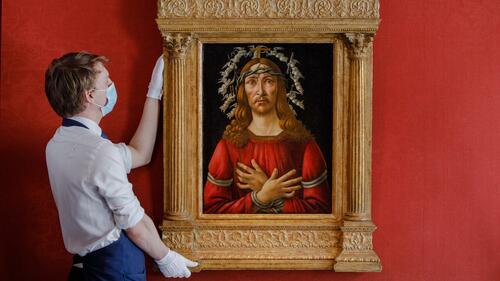Hedge Fund CIO: An Asset With Finite Supply, But No Intrinsic Value, Can Become Priceless
By Eric Peters, CIO of One River Asset Management
“The Fed bought $130bln of bonds so far this year. And global central banks bought $300bln already,” said Biggie Too, global chief strategist for one of Wall Street’s too-big-to-fail affairs.
“We have a rate shock, yet they’re still doing QE,” bellowed Biggie. “There really are just two camps now: sheepish equity longs and stubborn equity longs,” he barked.
“So you gonna buy 30yr treasuries with 7% inflation? Or buy gold when the dollar is going up? Who wants to buy emerging markets when the Fed is about to tighten?” asked Biggie, working himself up, bouncing.
“Maybe that’s why equities have gone from being this thoroughbred, racing beautifully around the track, to a bucking bronco – and yet no one can get off.”
* * *
Infrared tests of the ancient artwork reveal that Botticelli initially started painting Christ as a young child, hugged by his mother. But for reasons long since lost, during the year 1500 AD, the 55yr old artist entered his studio, turned the canvas upside down, started over, and produced The Man of Sorrows.
From a few ounces of unremarkable paint, emerged a masterpiece, a haunting work. His earlier paintings were mainly mythological, The Birth of Venus, his most famous. Later, his work turned more Gothic, perhaps a reflection of the darkness that briefly descended on Florence. Dictatorship. Botticelli lived in a time resembling ours, rhyming, the Renaissance -- a period of breathtaking creativity, expressed with the tools of time, brushes, chisels, pens.
But even in periods that favor the uninhibited expression of human creativity, we wrestle with our eternal demons. Political conflict, rivalry, false pride, greed, stupidity. We see it manifest today in Russia/Europe, US/China, Republicans/Democrats, climate-change, crushing inequality. The Man of Sorrows changed hands over five centuries, watching our triumphs, defeats, in silence.
An anonymous buyer purchased the painting in 1963. It re-emerged this week, selling for 45,400,000 dollars; a currency invented 282yrs after Botticelli died.
The Sotheby’s auction price is +1,621-times the 28,000 dollars paid in 1963. Such a return is almost inconceivable.
The S&P 500 in those 59yrs is +68-times. Gold +51-times. The US consumer price index is +9-times. But high art is unlike other assets, connecting us to genius, the sublime. And it reveals this truth: an asset with finite supply, but no intrinsic value, can become priceless, if only we imagine it so.
Which leads back to our present Renaissance. We live in a period of utterly stunning human advance, expressed with the technological tools of our time. Today’s greatest creations will barely resemble those of the past. Yet all this is obscured from most by the distractions streaming across the newsfeeds. And our highest calling, of course, is to navigate the rising volatility, while quietly creating and investing in the treasures of tomorrow.
https://ift.tt/Ic6OnU5Tg
from ZeroHedge News https://ift.tt/Ic6OnU5Tg
via IFTTT





0 comments
Post a Comment